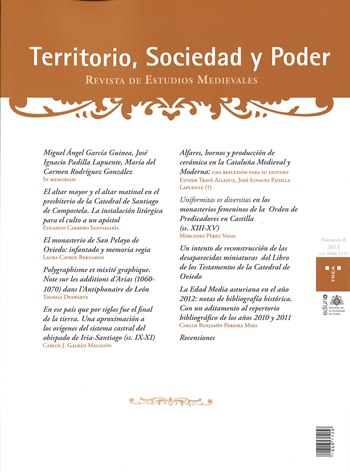Abstract
Resumen: A lo largo de la última década, numerosasexcavaciones arqueológicas –preventivas en su mayoría–han permitido la recuperación y el estudio de algunasestructuras de cocción de cerámica de cronologías medievalesy postmedievales que se añaden al panorama conocido afinales del siglo XX. Sin embargo, se constata la ausencia enel ámbito catalán de visiones de síntesis que aúnen esfuerzospor superar el localismo propio e inevitable de las memoriasde excavación en favor de una interpretación más ampliaacerca de la ocupación del territorio y de las estrategias deproducción.En este trabajo, que no pretende ser exhaustivo, presentamosun somero estado de la cuestión en relación con el estudiode las estructuras de cocción y los talleres de producción decerámica en la Cataluña de época medieval y moderna quenos permita ahondar en los problemas de fondo que dichasactividades plantean. Nuestro objetivo, pues, es poner sobrela mesa una reflexión acerca de la actividad alfarera y delmodelo de implantación de centros de producción en unterritorio determinado, así como a la propia evolución de loshornos durante los siglos medievales y modernos en aras deuna mayor adecuación técnica.Palabras clave: Arqueología medieval, Hornos, Alfarería,Tecnología, Centros de producción.Abstract: (Potteries, Kilns and ceramic production inMedieval and Modern Catalonia: A suggestion for debate)During the last ten years, archaeological –mainly preventive–fieldwork allowed finding out some kilns from medieval andmodern times that complete the panorama known until theend of 20th Century. Even though, it should be pointed outthat a global state of the art about firing structures lackedfor medieval and modern Catalonia. There is a strong needfor some synthesis views making an effort to join resultsand exchange data in order to overcome the unavoidablelocalisms of emergency fieldwork for a better understandingof landscape occupation and craftsmanship strategies.Therefore, this paper aims to present a global –although nonexhaustive– view on this matter in order to highlight someitems concerning pottering activities, firing structures andworkshops in Medieval and Modern Catalonia in order todeep into the main issues of such activities. Accordingly, ourmain goal is to propose some questions and reflexions fordebate concerning pottery craftsmanship and its model oflayout throughout the landscape; as well as the evolution ofkilns during medieval and modern periods so as to achieve abetter technical improvement.Within this piece of research, the location of this kind ofmanufacturing sites is discussed in order to detect somepatterns of setting and developing throughout medieval andmodern times, bearing in mind their rooting in the romanperiod. What we can observe is that there seems to be acontinued process, with no interruption, that leads fromthe roman pottery producing centres, mainly specialized inamphorae production and settled on the Coastal CatalonianPlane, to the medieval cave-dwelling workshops specializedin reduced cooking wares.These inland settlements, deal with the production ofspecialized wares according to the new demand of theseCenturies until social changes during the end of MiddleAges, gradually forced their disappearance in favour of newways of pottery-making related to the new enhancement ofcities and the improvement of urban world.To sum up, pottery production can be considered quitea good reflect of social changes and it points towards theway in what societies occupy the landscape and interactwith the natural environment. From the archaeologicalstandpoint, scholars are given a boost to approachingto this subject in a deep insight that globally considersthis kind of sites as a whole. Furthermore, we spotlightthe strong need of detailed excavation field-works inorder to gather as much information as possible fromthese sites in order to understand the entire productiveprocess, focusing in the excavation of kilns, but as well inworkshops and annexe areas, which frequently are muchcomplex.Keywords: Medieval Archaeology, Kilns, Pottery,Tecnology, Producing centres.Downloads
Download data is not yet available.

